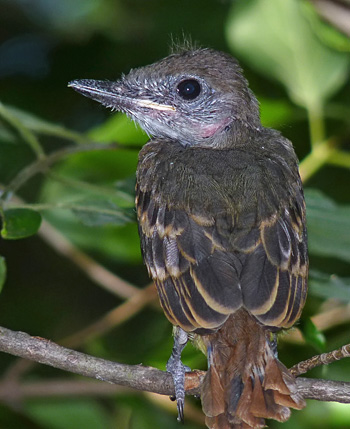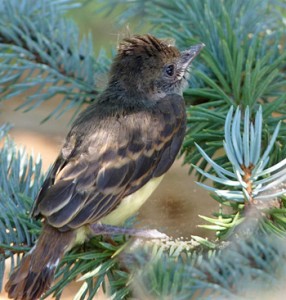 This photo was taken June 22, 2010 just a few hours after this young bird left the nest box. I don’t think I’d be able to ID this fledgling, especially from this angle, unless I paid attention to the tail feathers. Could you?
This photo was taken June 22, 2010 just a few hours after this young bird left the nest box. I don’t think I’d be able to ID this fledgling, especially from this angle, unless I paid attention to the tail feathers. Could you?
I’ve been spending time during the past few weeks monitoring two Baltimore Oriole and one Eastern Kingbird nests at Lake Hefner while my OkieBirdCam friend Terri Underhill has been keeping up with the great bird activity on her wooded yard. She called yesterday with news that the “babies are fledging” and with pictures and videos. I couldn’t resist the opportunity to see the baby birds. And, seriously! once I saw them I couldn’t believe how unidentifiable I found them.
These young birds are the size of a small sparrow while their parents are about the size of a Northern Cardinal. The baby birds I’ve seen (admittedly not that many) are usually about 80% adult size when they leave the nest, e.g., Mockingbirds, Robins, Eastern Bluebirds…
The tail feathers are rufous — that’s the best clue; plus the belly is yellow. It lacks the white wingbars of the parents. Okay, I’m sure many wouldn’t be as stumped by this as I would be ! Yes, it is a Great-crested Flycatcher.
This species is the only eastern flycatcher that is a cavity nester. Its breeding range encompasses the eastern half of the North America from Florida into Canada. Oklahoma is the western edge of its summer range making it a bird that
the state’s western neighbors find rare. Terri had a pair successfully nest in a hole in tree two years ago. Last year the nesting, in the same hole, was unsuccessful — she thinks due to intense heat and sun. So this year she put up a nest box near the nest hole and the Great-crested Flycatcher adults found it to their liking and started home-building duties.
The Cornell Lab’s All About Birds page on Great-crested Flycatchers says that this bird’s nests often include snakeskin. Terri will be able to examine the nest box later and find out what nesting material was used.
Terri had seen two baby birds do a belly flop out of the nest box onto the ground — by the time I arrived, she was convinced a third bird had fledged and set out to find it. This second photo shows the little one in a Blue Spruce below the box.

Leave a Reply